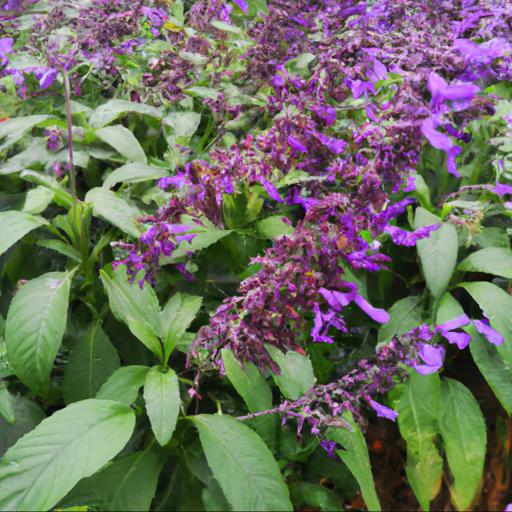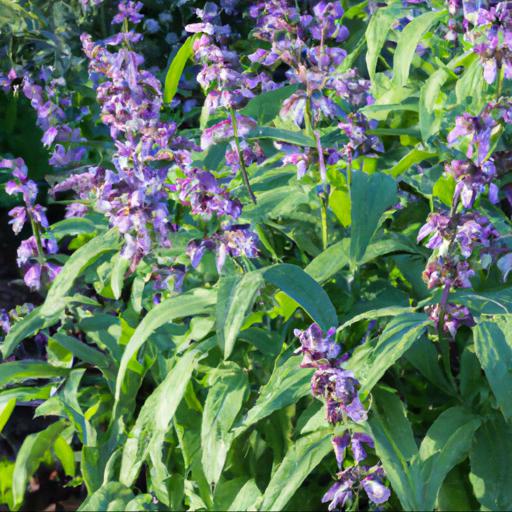Salvia leucantha purple velvet, also known as Mexican Bush Sage, is an attractive and easy-to-grow herbaceous perennial that is sure to add a splash of color to your garden. Native to Mexico, it is an evergreen shrub with velvety, purple-tinged foliage and bright purple flowers that bloom in late summer and fall. It is a great choice for gardens and containers, and is tolerant of a wide range of growing conditions.
With its showy flowers and attractive foliage, Salvia leucantha purple velvet is sure to bring a touch of beauty and color to your garden.
Benefits of growing salvia leucantha purple velvet

When it comes to the garden, the Salvia leucantha “Purple Velvet” is an ideal choice for adding both beauty and functionality to any outdoor space. With its showy, velvety bracts of deep purple and prolific, long-lasting white flower spikes, this plant is sure to stand out in any garden.
This Mexican native is a hardy, easy-to-grow shrub that thrives in full sunlight and average water. It typically falls into the semi-dwarf category with a mature height of about two to three feet, making it an ideal choice for smaller gardens. It has a remarkably low maintenance requirement and can stay colorful for up to eight months of the year.
Additionally, its blooms are attractive to both nectar-loving butterflies and hummingbirds, making it a great asset for inviting wildlife into your garden. One of the greatest benefits of growing “Purple Velvet” is its versatility. It can be used as a colorful addition to borders and flower beds, and it also makes a great choice for lanes and pathways.
Its velvety purple bracts and prolific flowers look especially luscious when combined with silver foliage plants such as Artemisia, African daisies, and Agastache. Of course, if you’re more of a go-it-alone kind of gardener, this plant also looks fantastic as a stand-alone specimen.
In short, the Salvia leucantha “Purple Velvet” is a low-maintenance, beautiful, and versatile addition to any outdoor space. From filling out flower beds and pathways to welcoming butterflies and hummingbirds, this unique shrub is sure to add some vibrant beauty to your garden.
Tips for planting and caring for salvia leucantha purple velvet

When it comes to gardening, few plants can rival the regal beauty of Salvia leucantha purple velvet. Known for its velvety stalks and vivid blooms, purple velvet salvia has become a treasured addition to a variety of gardens. With the right conditions, this standout flower can transform your outdoor space into a colorful paradise.
Planting Salvia leucantha purple velvet is easy if you follow the proper steps. First and foremost, make sure you pick a suitable spot.
This flower prefers full sunlight but can survive in partial shade. Sunny areas with well-drained soil are ideal for this type of salvia. Before planting, prepare the soil with a mixture of organic fertilizer and compost to ensure the plant receives the nutrients it needs to thrive.
Once the soil is properly prepared, it’s time to plant. Despite its hardy nature, Salvia leucantha purple velvet still needs some attention once it’s in the ground.
Make sure to water it regularly, especially during dry conditions. Pruning the plant in the summer will help it grow more blooms. Additionally, mulching around the planting site can help prevent weeds and conserve moisture.
While Purple velvet Salvia is generally pest-free, keep an eye out and use an organic insecticide if any unwanted visitors show up. With some basic care and attention, Salvia leucantha purple velvet can become a stunning addition to your garden.
Plant it in the right location, give it the water and nutrients it needs, and you’ll be rewarded with long-lasting blooms that will bring a touch of royalty to your outdoor space.
Common pests and diseases of salvia leucantha purple velvet

Salvia leucantha ‘Purple Velvet,’ often simply referred to as ‘Purple Velvet’ salvia, is an attractive perennial plant that produces delicate white and lavender flowers in the summer months. It is a popular option for those needing to add a bit of beauty to the garden and it is also relatively easy to care for.
However, like any garden flower, it can be affected by a host of pests and diseases. Understanding and recognising the most common pests and diseases of ‘Purple Velvet’ salvia can help you treat an infection or infestation quickly, reducing the potential damage on your flowering plant. Common culprits include whitefly, spider mites, spittlebugs, mealybugs, aphids, powdery mildew and root rot.
Whitefly tend to congregate on the undersides of leaves and can cause the leaves to turn yellow and eventually drop off the plant. Spider mites cluster in groups of tens or hundreds and spin tiny webs between the leaves, appearing as a silky sheen.
Spittlebugs can also be found on the undersides of the leaves and leave a frothy substance that covers the underside of the leaf. Mealybugs appear as white colonies in clusters and release a sticky substance known as honeydew, which can then attract the black sooty mould fungi. Aphids feed on the sugary sap of the plant, causing leaves to brown and curl, and can weaken thesaliva leucantha ‘Purple Velvet.
’ Powdery mildew appears as white or grey powder that can be found on both sides of the leaf, causing them to yellow and die. Root rot is caused by overwatering and results in wilting, yellowing leaves and stem discolouration.
To prevent pests and diseases from affecting your salvia leucantha ‘Purple Velvet’, it is important to ensure that it is planted in well-draining soil and watered properly. Regular pruning can help to keep plants disease-free and removing any dead or diseased plant material can limit the spread of infection. Additionally, introducing beneficial insects, such as ladybugs and lacewings, can help to reduce the populations of damaging bugs.
Finally, fungicide can be applied in cases of severe infection. By following these steps and keeping an eye out for any signs of infection, you can easily maintain the beauty of your ‘Purple Velvet’ salvia and enjoy its stunning blooms throughout the summer months.
How to use salvia leucantha purple velvet in landscaping
When it comes to adding a dramatic splash of colour to your garden’s landscape, Salvia leucantha purple velvet is an excellent choice. Native to Mexico and its neighbouring countries, Salvia leucantha is an evergreen plant that can be grown in a wide range of climates. In areas with cold winters like the UK, it is best to conserve the plant over winter.
Salvia leucantha purple velvet grows in small, dense bushes that reach a maximum height of 60 cm, with long velvet-like foliage that bears rich purple blooms in the summer. These strong, vibrant flowers will bring your garden to life, adding a pop of colour and texture.
With a quick annual pruning and care, Salvia leucantha purple velvet can bring a beautiful purple presence to your yard year-round. When planting, it is best to make sure the soil is well-draining and fertilize periodically to help with growth.
Salvia leucantha purple velvet thrives in full sun and flowers for much longer in its natural habitats. When planting them in the UK, make sure that the plants are exposed to as much sunlight as possible. This will ensure a healthy, lush plant.
With its low maintenance requirements and striking colour, Salvia leucantha purple velvet is the perfect plant to bring vibrancy to your garden’s landscape. Whether you’re adding this plant to beds, borders, containers, or other areas — the strong purples will provide a unique and beautiful feature to your outdoor living area.
Conclusion
Salvia leucantha ‘Purple Velvet’ is an attractive, easy-to-grow perennial with beautiful, velvety purple flower spikes. This plant blooms from summer to fall, and is a great addition to any garden.
It’s drought tolerant and requires little maintenance, making it a great choice for gardeners of all skill levels. Its unique purple flowers make it a great choice for adding color and texture to your garden.
FAQ
What is the scientific name of Salvia leucantha purple velvet?
The scientific name of Salvia leucantha purple velvet is Salvia leucantha ‘Purple Velvet’.
What are the characteristics of Salvia leucantha purple velvet?
Salvia leucantha purple velvet is a perennial plant with velvety, purple-colored foliage and white flower spikes. It is drought-tolerant and grows best in full sun. It can reach up to 3 feet in height and has a long blooming period from late summer to early fall.
How often should Salvia leucantha purple velvet be watered?
Salvia leucantha purple velvet should be watered when the soil is dry to the touch, usually every 1-2 weeks.
What type of soil is best for growing Salvia leucantha purple velvet?
Well-drained, sandy loam soil with a neutral pH is the best type of soil for growing Salvia leucantha purple velvet.
How long does it take for Salvia leucantha purple velvet to bloom?
Salvia leucantha purple velvet typically blooms from late summer to early fall.
What type of climate is best for growing Salvia leucantha purple velvet?
The best climate for growing Salvia leucantha purple velvet is a warm, dry climate with full sun exposure.

